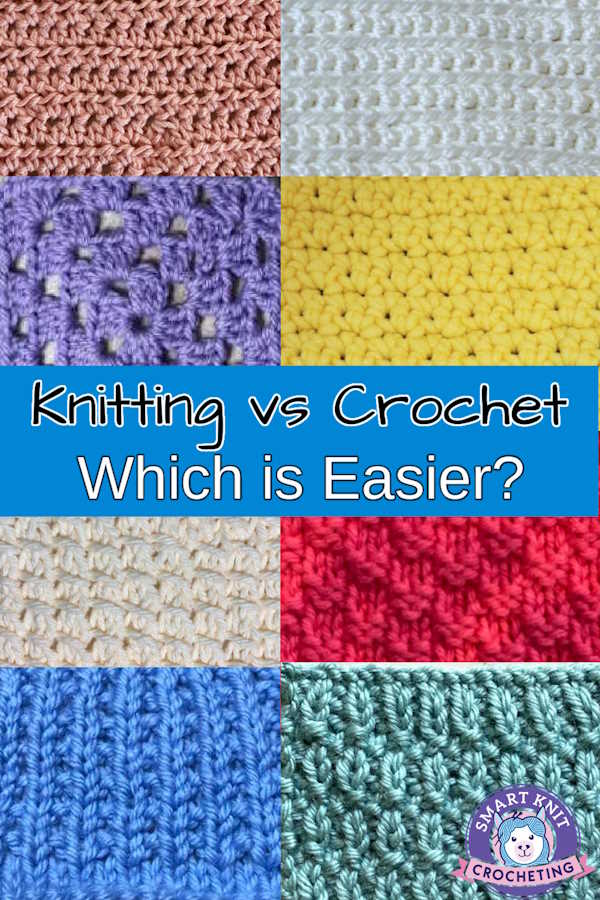- Home
- Knitting vs crocheting
Knitting vs Crocheting: Which Craft is Easier?
Which Craft is Easier: Knitting vs Crocheting?
Considering fiber arts, knitting, and crocheting are two popular ways of creating beautiful and functional fabric from yarn. Knitting or crocheting would be a great option if you want to start a new hobby.
But is crochet or knit easier?
In this article, I will explore the differences and pros and cons, about learning to knit vs. crochet and then you be the judge.
But before I do, I just want to emphasize that neither knitting nor crochet can be mastered after one lesson. Both require a great deal of muscle memory and dexterity. Both have about the same learning curve.
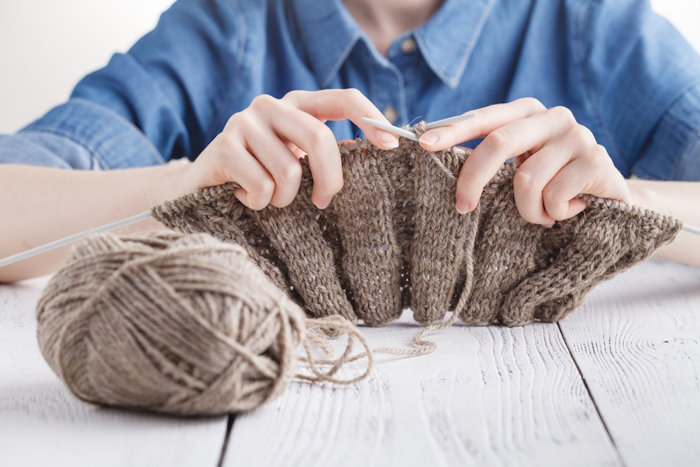 Knitting
Knitting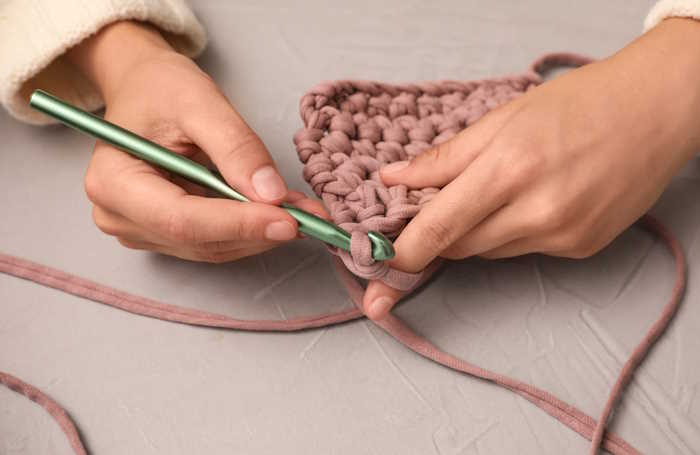 Crocheting
CrochetingUnderstanding the Difference Between Knitting and Crocheting
Many people want to know whether knitting or crochet came first. Knitting has likely been around for a millennium, having first emerged in the literature as early as the 11th century CE but crochet is a recent invention from the 19th century. Both crafts' popularity has waxed and waned over the years but both are more popular than ever in the 21st century.
For beginners or those interested in picking up knitting or crocheting, it’s important to understand the differences. While both needlecrafts involve creating fabric from yarn, they utilize different techniques and tools.
Let's exaine knitting vs crochet differences:
Knitting
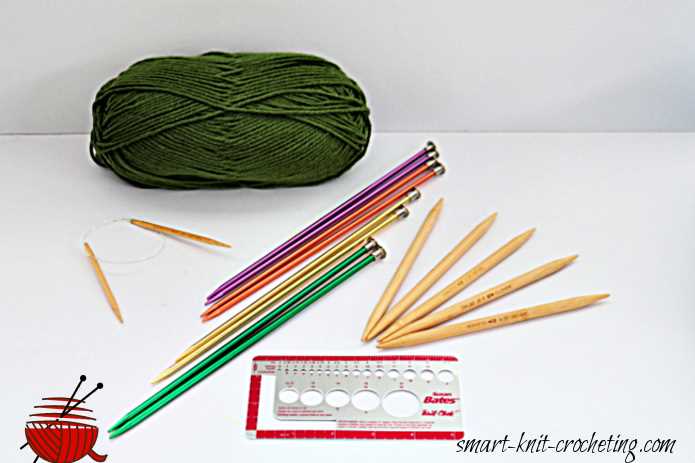
Knitting involves using two needles and working with multiple stitches at once, which are held on the needles. Knitted fabric tends to be smoother, stretchier, and has more drape than crochet fabric.
There are many reversible knit stitch patterns, but for the majority, there is a distinct right and wrong side to the fabric. Typical projects often knitted include sweaters and vests, scarves and shawls, hats, mittens, and socks.
Knitting Tools
To knit, one needs, at the minimum, yarn, and knitting needles. There are a variety of different types of knitting needles, including straight needles, circular needles, double-pointed needles, and cable needles.
Tapestry or yarn needles are also needed to weave in yarn.
Basic Knitting Techniques
There are only two basic knit stitches, the knit and purl stitches. From there, these two stitches can be combined in various ways to create easy to intricate patterns.
In addition, before one can begin to knit, one must learn how to cast on and bind off stitches.
Crocheting
A single crochet hook is used to crochet fabric that is often highly textured, thick, stiff, and sturdy. For most projects, there is no distinct difference between the right and wrong sides.
While making crochet fabric, you are dealing with only one active stitch at a time. If you miss a stitch in crochet, the appearance might change but you won't be left with a hole or column of lost stitches as in knitting.
Projects that benefit from these characteristics include dishcloths, placemats, and household items. Amigurumi is also a popular crochet technique used to make a variety of different types of toys.
Crochet is also an excellent choice for making blankets, such as granny square Afghans and similar large projects that don't require much time.
Crochet is also a good option if you love thick, chunky or bulky yarns. They work up easier on a large hook as opposed to trying to fit a large number of knitting stitches on a knitting needle.
Crochet Tools
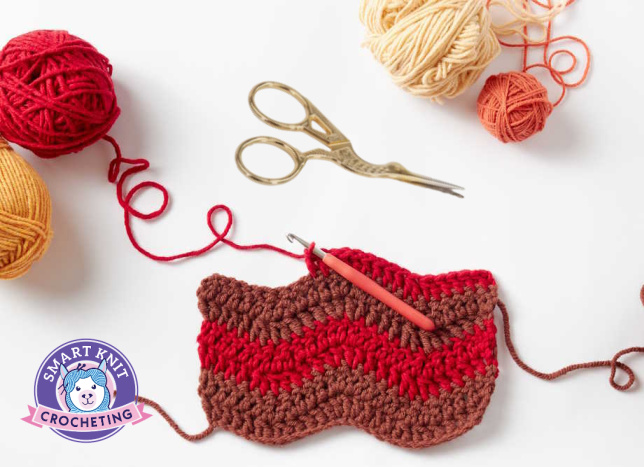
Again, yarn and a single crochet hook are used in crochet and held in the dominant hand. The Craft Yarn Council has made it easy to learn more about the type of yarn used in knitting and crochet.
They have also provided a resource to determine what size hooks match up with the various types of yarns. For example, a size H (5.0 mm) or I/9 (5.25 mm) hook is recommended if using worsted-weight yarn.
The yarn label also provides this information as well. A tapestry needle is also needed for crochet, scissors, and other notions.
Crochet Techniques
Traditional crochet involves making several basic crochet stitches.
There are six stitches you will need to master first:
All additional crochet projects will use one or more of these stitches in many ways to create amazing textured fabrics.
These differences may seem immense, but they are not. However, the difference gives each craft its unique look and feel. These differences are also the reason some people think one is easier than the other.
Exploring the Pros and Cons of Knitting vs Crocheting
There is a learning curve to mastering knitting and crocheting. It takes time to develop that muscle memory that is necessary and a fair amount of fine motor skills helps tremendously. But you're probably wonder if knit or crochet is easier. Read on.
Knitting Pros and Cons
Knitting Pros
- Knitting is portable; you can knit almost anywhere, including airplanes.
- There is an easy sequence to learning knitting. Once you master the basics, new stitch patterns are easy to learn.
- Knitting is very versatile. From super lace-weight yarn to the thickest chunky yarn, there are many projects you can create.
- One can practice mindfulness when knitting. The repetitive nature can be relaxing, and even the clinking of metal needles can be soothing.
- More free patterns can be found on the internet, especially Ravelry.
- Easier to read and count your stitches.
Knitting Cons
- Knitting can be more difficult for beginners because you must simultaneously hold two needles and manage the working yarn in one of your hands. It takes a while to figure out how to hold the yarn and needles and manage everything at the same time.
- It's not always easy to fix knitting mistakes. Sometimes you need to rip out an entire row or more of knitting.
- Knitting is equally inexpensive for the brand-new beginner but may cost more because more supplies are needed for advanced techniques.
- 3-D objects such as toys can be difficult to create without additional needles.
- Complete beginners often have difficulty keeping the active loops or stitches from falling off the needle.
Crocheting Pros and Cons
Crocheting Pros
- Crochet is portable like knitting, perhaps more so. Common crochet motifs like granny squares are even easier to create on the go.
- Even the most intricate crochet textures are combinations of a few basic stitches.
- It's easy to pick up and put down in the middle of a row (compared to knitting)
- In most cases, crocheting is faster than knitting.
- Crochet is easy to unravel and fix mistakes, if needed.
- No worries about crochet stitches falling off the hook.
- Crochet is the easiest method for making shapes and toys.
Crocheting Cons:
- Determining where to insert your hook is slightly trickier than knitting.
- Crochet uses more yarn than knitting.
- Crocheted fabric is generally less stretchy than knitting.
- Often difficult to read your stitches.
Knitting vs Crocheting: Which is Easier for Beginners?
One of the most common questions beginners ask is whether knitting or crocheting is easier to learn. The answer ultimately depends on:
- Personal preference
- Project preferences
Personal Preferences
Some individuals find crocheting easier because it deals with only one hook held in one hand with the yarn tensioned in the other.
For those who have developed a fair amount of fine motor skills, crochet can be easier. On the other hand, some people find holding the hook in the dominant hand and learning to tension the yarn in the non-dominant hand challenging.
Crocheting also involves working with one stitch at a time, which means correcting mistakes is much easier. Since crochet stitches tend to be taller, finishing projects faster is easier.
Knitting, on the other hand, requires one to hold a needle in each hand while tensioning the yarn with one of the hands. By knitting, you can tension the yarn in either hand.
If you tension the yarn in your left hand, you are a continental knitter. English knitters tension the yarn in their right hand. Mistakes are more difficult to fix, but there are only two basic stitches that the beginner must master.
Project Preferences
For those who have a project in mind before they learn to knit or crochet, that project could influence what you end up learning.
To make toys (amigurumi), you must learn how to crochet. You can make these items with knitting, but it's not quite as easy. Likewise, if your goal is to make things for the home, such as baskets, scarves, dishcloths, placements, or something circular, crochet is your craft.
Knitting may be the way to go if you want to learn how to knit a sweater, shawl, pair of socks, or mittens. This does not suggest you can't crochet a sweater or knit a dishcloth. There are a few things that can't be knit or crocheted.
Is Knit or Crochet Faster
Is Knitting Faster?
People often wonder whether knit or crochet is faster. The speed of knitting and crocheting often depends on the individual and the project at hand. Some people find knitting faster because they can work with multiple stitches simultaneously, especially when using circular needles.
Knitting can be performed in several different ways. The two most popular methods, as I mentioned above are English and Continental. Knitters using the English method hold and manipulate the working yarn with their right hand.
Continental knitters hold and work the yarn with their left hand. More advanced continental knitters can work very fast, depending on the intricacy of the project.
Is Crocheting Faster?
Many others find crochet to be faster because stitches can be worked faster. Many people, myself included, think crocheting is faster, but then, I'm not a fast knitter. I use the English method which is slower than the continental method.
Speed should not be the sole factor when choosing between knitting and crocheting.
There are other factors that you may want to consider before choosing one over the other, including types of projects, quantity of yarn used, and cost.
Knitting vs Crocheting: Which Uses More Yarn?
Does knitting or crochet use more yarn?
This is a common question asked frequently, especially from those on a budget. The answer is not straightforward, depending on the specific project and the stitch patterns.
Even within knitting, different stitch patterns require more yarn than others. The same is true for crochet.
Generally, knitting tends to use less yarn than crocheting because the stitches are closer together. However, certain knitting techniques or patterns, such as cables or colorwork, can require more yarn.
On the other hand, crocheting tends to use more yarn due to the nature of the stitches, which creates a more textured, thick, and open fabric. Ultimately, the amount of yarn needed for a project will vary depending on the pattern and personal tension.
Knitting vs. Crochet: Which is Better for Different Projects?
Both knitting and crocheting have their strengths and are better suited for certain projects.
Knitting is excellent for creating sweaters, socks, and hats, as the fabric tends to be stretchy and drapes well. It's also great for colorwork and intricate stitch patterns.
Crocheting, however, is perfect for making blankets, scarves, and amigurumi toys, as the fabric has more structure and is denser.
Crochet is often used for making household items such as placemats, dishcloths, baskets, and plant holders. With that said, knitted placemats, dishcloths and pillows are also wonderful.
Crocheting is also ideal for creating textured patterns and adding embellishments to projects. Adding color is often easier in crochet.
Take the granny square, for example. Each four-inch square can have four different colors, whereas adding additional colors in knitting is more complex.
Ultimately, the choice between knitting and crocheting for different projects comes down to personal preference and the desired outcome.
Knit vs. Crochet Appearance
If you compare knitting stitches for beginners and beginning crochet stitches, you will notice quite a difference. Just compare a swatch of knit stockinette stitch and a double crochet stitch.
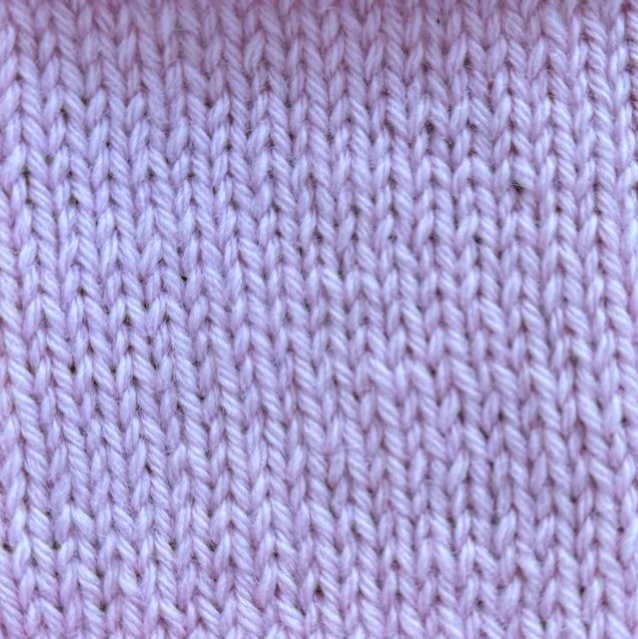 Knit Stockinette Stitch
Knit Stockinette Stitch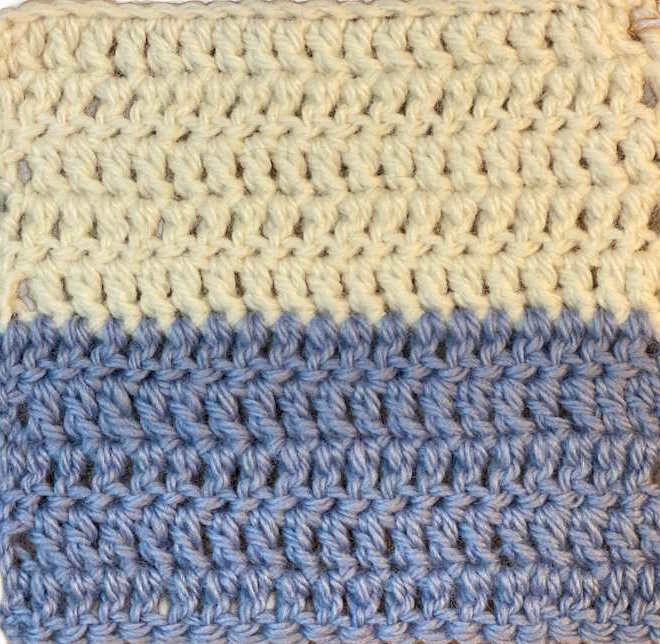 Crochet Double Crochet Stitch in blue and white
Crochet Double Crochet Stitch in blue and whiteCrocheted fabric is dense and sturdy and highly textured. Knitted fabric, is often smoother and stretchier.
Projects Good for Knitting
- Sweaters
- Vests
- Scarves and cowls
- Socks
- Hats
- Mittens and fingerless mittens
- Shawls and Wraps
- Dresses and skirts
I have a growing set of free knitting patterns that are perfect for beginners.
Projects Good for Crochet
- Blankets (any size)
- Baskets
- Toys and 3-d objects
- Washcloths and dishcloths
- Placemats and doilies
- Rugs
- Amigurumi
- Hats and headbands
- Mug and teapot cozies
There are many free crochet patterns for beginners on this site.
Knitting vs. Crochet: Which Costs More?
Cost is always on people's minds when they consider a new endeavor. How much will it cost initially, and what expenses will I have in the future?
To begin, both knitting and crochet are relatively inexpensive. All you will need to begin is some yarn, knitting needles, or a crochet hook.
You will also want to pick up a pair of scissors and some notions such as stitch markers, tapestry needles, and a tape measure. That's it. You will need a few more items as you enter your chosen needlecraft.
A complete set of crochet hooks is helpful to have on hand, especially if you plan to experiment with different weights of yarn.
Luckily a good set of hooks need not be expensive. One of my favorite sets is an ergonomic set by Yarniss which includes 14 hooks and costs about 17 USD.
For more information on crochet hooks, or ergonomic crochet sets, check out these other resources.
Knitting needles, on the other hand, can get to be expensive. An interchangeable circular knitting needle set can cost upwards of $150, depending on your chosen type and brand.
Lace knitting needles with sharp needle tips can be quite expensive. Circular needles are wonderful, but you may also want a few pairs of straight needles and a set or two of double-pointed needles.
A simple set of straight knitting needles is really all you need to get started, but you may also want to purchase a set of needles in more than one size.
Learn more about knitting needles.
Another thing that beginners may fail to consider is how versatile needles and crochet hooks can be. New knitters are not likely to think about working on more than one project at a time, but at some point, it makes sense to have more than one project in the works.
If you only have one pair of needles, this option will not be possible because the loops or stitches must remain on the needle.
Crocheting two projects with the same hook is very doable. Simply remove the hook and place a stitch holder on the last stitch. Then, use the same hook on your new project. This is one more way you can save with crochet.
Knitters also will want things like cable needles and stitch holders. Well, you see my point; there are more things to buy so that knitting can be more expensive.
Tips for Beginners in Knitting and Crocheting
Whether you choose knitting or crocheting, here are some tips to help you get started on your fiber arts journey:
- Start with simple projects: Your first project could be a set of coasters, a dishcloth, or a scarf. Begin with small, manageable projects to build your skills and confidence.
- Practice regularly: Consistency is key to improving your knitting or crocheting skills and building that muscle memory. Set aside dedicated time each week or, better yet, each day to practice and work on projects.
- Don't be afraid to make mistakes: Mistakes are part of learning. Learning to knit or crochet means reading your stitches, identifying mistakes, and discovering how to fix them.
- Experiment. Once you've mastered the basics, don't be afraid to try new stitches, patterns, and techniques. Knitting and crocheting are about creativity and self-expression, so let your imagination run wild.
Frequently Asked Questions About Knit Vs. Crochet
Is Knitting or crochet faster?
Is Knitting or crochet faster?
Crochet is faster for beginners. Since many crochet stitches are larger than knit stitches, you can create more fabric with crochet in the same time as you would for knitting
Is Crochet or Knitting Easier
Is Crochet or Knitting Easier
Either can be easy depending on the level of your manual dexteriety. Most people find crochet easier because you are holding the yarn in one hand and manipulating the yarn with the other.
With knitting, you are holding one needle in each hand and at the same time manulating the yarn with one or the other hand.
Does Knitting or Crocheting Use More Yarn
Does Knitting or Crocheting Use More Yarn
Knitting uses less yarn overall than crocheting.
Which is Cheaper to Learn, Knitting or Crocheting
Which is Cheaper to Learn, Knitting or Crocheting
Paid classes will be about the same price whether you are learning to knit or crochet, so the costs involve may differ. Both knitting and crocheting require basic tools: Needles (knitting) or Hooks (Crochet), yarn, scissors, yarn needles, and stitch marker.
Crochet may be less expensive initially, but as you gain experience, you will want to purchase more tools and yarn and then the costs for both even out.
Conclusion: Knitting vs Crocheting: Choosing the Right Craft for You
In the end, the choice between knitting and crocheting as a beginner comes down to personal preference. Both crafts offer a wonderful way to relax, express creativity, and create beautiful and functional pieces.
Whether you prefer the stability of knitting or the versatility of crocheting, the most important thing is to enjoy the process and have fun.
So, grab your needles or hook, pick up some yarn, and embark on your fiber arts adventure. Knitting vs Crocheting, it's entirely up to you. Happy knitting or crocheting!
Knitting vs Crocheting: Which Craft is Easier? Pin for Future Reference:
About Janice
Hi, I’m Janice, the voice behind Smart-Knit-Crocheting. I love to knit and crochet and even more, I love teaching others what I know.
Though I learned to knit and crochet as a child, I didn’t get serious about these amazing hobbies until I retired. I’m a certified knit and crochet instructor through the Craft Yarn Council and am working on becoming a Master Hand Knitter through The Knitting Guild Association.
I’m currently living with my husband of over 50 years and our 6 Shih Tzu dogs.
I love hearing from you, so please drop me a line and let me know what you’re working on, whether you love knitting or crocheting more, and if you have any questions. Please visit my about me page for more information.
Happy Crocheting

